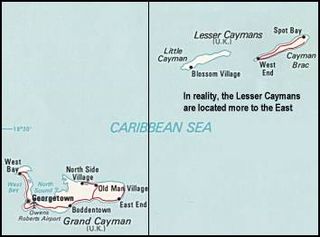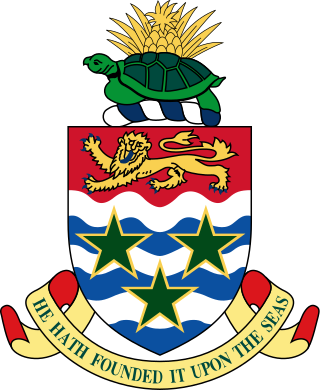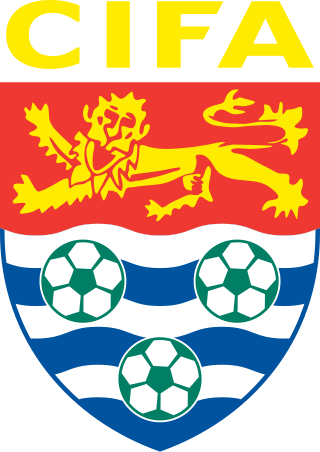Related Research Articles

The CaymanIslands is a self-governing British Overseas Territory, and the largest by population. The 264-square-kilometre (102-square-mile) territory comprises the three islands of Grand Cayman, Cayman Brac and Little Cayman, which are located south of Cuba and north-east of Honduras, between Jamaica and Mexico's Yucatán Peninsula. The capital city is George Town on Grand Cayman, which is the most populous of the three islands.

The Cayman Islands are a British overseas territory located in the Caribbean that have been under various governments since their discovery by Europeans. Christopher Columbus sighted the Cayman Islands on May 10, 1503, and named them Las Tortugas after the numerous sea turtles seen swimming in the surrounding waters. Columbus had found the two smaller sister islands and it was these two islands that he named "Las Tortugas".

The Cayman Islands are a British dependency and island country. It is a three-island archipelago in the Caribbean Sea, consisting of Grand Cayman, Cayman Brac, and Little Cayman. Georgetown, the capital of the Cayman Islands is 438 km (272 mi) south of Havana, Cuba, and 504 km (313 mi) northwest of Kingston, Jamaica, northeast of Costa Rica, north of Panama and are between Cuba and Central America. Georgetown's geographic coordinates are 19.300° north, 81.383° west.
This is a demography of the population of the Cayman Islands including population density, ethnicity, religious affiliations and other aspects of the population.

The transport infrastructure of the Cayman Islands consists of a public road network, two seaports, and three airports.

The Cayman Islands is a parliamentary representative democratic dependency. As a British Overseas Territories, Charles III is the head of state. The Premier of the Cayman Islands is the head of government. Executive power is exercised by the government, legislative power is vested in both the government and the Parliament of the Cayman Islands. The judiciary is independent of the executive and the legislature.

Grand Cayman is the largest of the three Cayman Islands and the location of the territory's capital, George Town. In relation to the other two Cayman Islands, it is approximately 75 miles (121 km) southwest of Little Cayman and 90 miles (145 km) southwest of Cayman Brac.

Little Cayman is one of three Islands that make up the Cayman Islands. It is located in the Caribbean Sea, approximately 60 miles (96 km) northeast of East End, Grand Cayman and five miles (8 km) west of West End, Cayman Brac. Little Cayman is the least populous island of the three, with a permanent population of about 160 (2021) including seasonal residents/homeowners. The majority of the population are expatriate workers from Jamaica, the Philippines, and Honduras and from other Latin American countries as well as Canada, the USA, India, Australia, Scotland, England, and South Africa. There are a handful of local Caymanians estimated as fewer than 20. It is about 10 miles (16 km) long with an average width of 1 mile (1600 m) and most of the island is undeveloped. Almost the entire island is at sea level. The highest elevation is about 40 feet. The rainy season, which consists of mostly light showers, occurs in Mid-April until June and again in mid-September to mid-October. There will be occasional quick rain showers in the early morning hours. The coolest months are from End of November until Mid March as the cold fronts coming in from the North which the temperature can drop into the low'70s. The Hottest and dryest months are in Summer starting mid-June to mid-September with temperatures between the mid-80s and high 90s. There are no large or predatory or venomous animals that pose a threat to humans.

George Town is the capital and largest city in the Cayman Islands, located on Grand Cayman. As of 2022, the city had a population of 40,957, making it the largest city of all the British Overseas Territories.

Cayman Brac is an island that is part of the Cayman Islands. It lies in the Caribbean Sea about 145 km (90 mi) north-east of Grand Cayman and 8 km (5.0 mi) east of Little Cayman. It is about 19 km (12 mi) long, with an average width of 2 km (1.2 mi). Its terrain is the most prominent of the three Cayman Islands due to "The Bluff", a limestone outcrop that rises steadily along the length of the island up to 43 m (141 ft) above sea level at the eastern end. The island is named after this prominent feature, as "brac" is a Gaelic name for a bluff.

Sir Captain Charles Kirkconnell International Airport is an airport serving Cayman Brac, Cayman Islands. It is one of the hubs for Cayman Airways with flights to Owen Roberts International Airport on Grand Cayman, and Edward Bodden Airfield on Little Cayman. It is the only airport on Cayman Brac.

The Parliament of the Cayman Islands is the unicameral legislature of the British Overseas Territory of the Cayman Islands. It is composed of 21 members; 19 elected members for a four-year term and two members ex officio.

The Cayman Islands Football Association is the governing body of football in the Cayman Islands. The Cayman Islands Football Association governs all National Team programs, youth development leagues, Women's league and the Cayman Islands Men's Premier League.

Hurricane Paloma was a strong late-season Atlantic hurricane that set several records for its intensity and formation. It was the sixteenth tropical storm, eighth hurricane and fifth major hurricane of the 2008 Atlantic hurricane season. Paloma was, at the time, the third most powerful November hurricane on record in the Atlantic Basin, behind only the 1932 Cuba hurricane, 2020's hurricanes Iota and Eta, and a tie of 1999's Hurricane Lenny, and 2001's Hurricane Michelle. Paloma also marked the first time that at least one major hurricane formed in every month of the hurricane season from July to November, with only June not having a major hurricane in the season.

The Mission House is a historic house located in Bodden Town, Grand Cayman. The house rose to prominence in the 1800s and became known as the "Mission House" because of early missionaries, teachers and families who lived there while establishing a Presbyterian church and school in Bodden Town.

Queen Elizabeth II Botanic Park is a non-profit outdoor garden and wildlife facility located in the North Side District of Grand Cayman Island in the British West Indies. The park is owned jointly by the Cayman Islands Government and the National Trust for the Cayman Islands, a group dedicated to preserving natural environments and places of historic significance in the Cayman Islands. Opened in 1994 with only the Woodland Trail completed, the park now also contains the Floral Colour Garden, a Cayman Heritage Garden, a lake, an orchid boardwalk exhibit, and a Blue Iguana Habitat. Also inside the park is a gift shop and a visitor's interpretive center, the starting point from which visitors can enter the Woodland Trail and other garden grounds.
Results from the 2014–15 Cayman Islands FA Cup
The 2016–17 Cayman Islands Premier League season was the 38th edition of top tier Cayman Islands Premier League football competition in the Cayman Islands. It began on 2 October 2016.

Irksie Leila Yates (1899-1996) was a pioneering nurse and midwife from the Cayman Islands. She has been recognized on a stamp in the 2011 series "Pioneers in our History" and in 2015 was posthumously honored with the National Heroes Award. Her home has been the focus of a restoration project for the National Trust’s West Bay Committee.
Islay Conolly, MBE was a Caymanian teacher and school administrator. Serving as a teacher and principal at various schools on the islands, she became Chief Education Officer in 1970. She was honored by the Caymanian government with the Spirit of Excellence Award during National Heroes Day and was first recipient of the Chamber of Commerce's Lifetime Achievement Award in Education. Conolly was honored as a Member of the Order of the British Empire (MBE) in the 1982 New Year Honours.
References
- ↑ "National Trust".
- ↑ "Fundraiser announced to turn Cayman Islands heritage home into arts & crafts". iEyenews. George Town, Grand Cayman, Cayman Islands. 29 December 2014. Archived from the original on 14 December 2015. Retrieved 2 December 2016.
- ↑ Spence, Monique (4 April 2015). "Paradise Discovered: Nurse Leila". The Cayman Reporter. George Town, Grand Cayman, Cayman Islands. Archived from the original on 2 December 2016. Retrieved 2 December 2016.
{{cite web}}: CS1 maint: unfit URL (link)